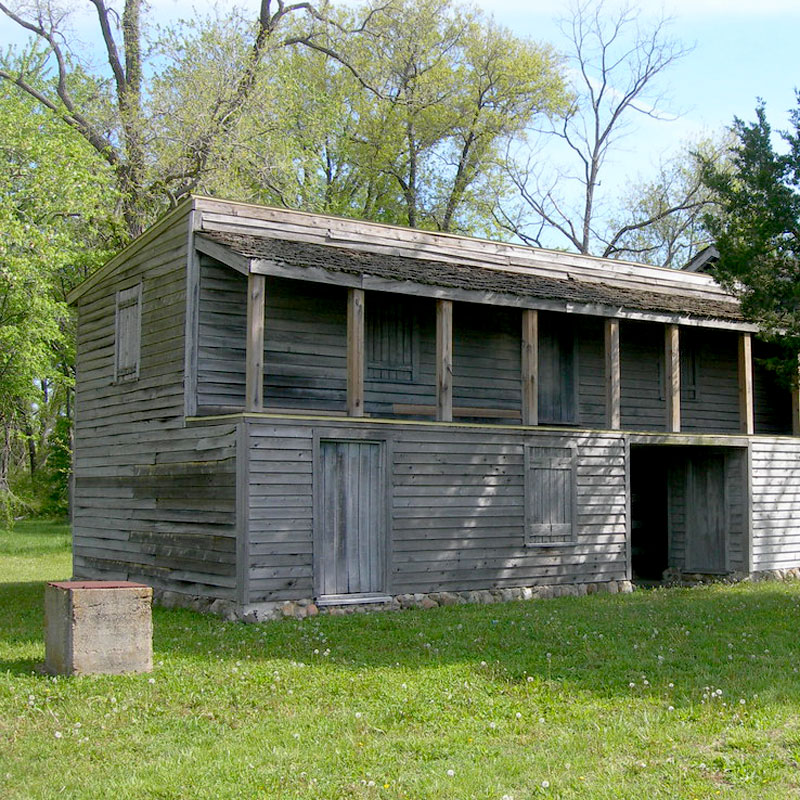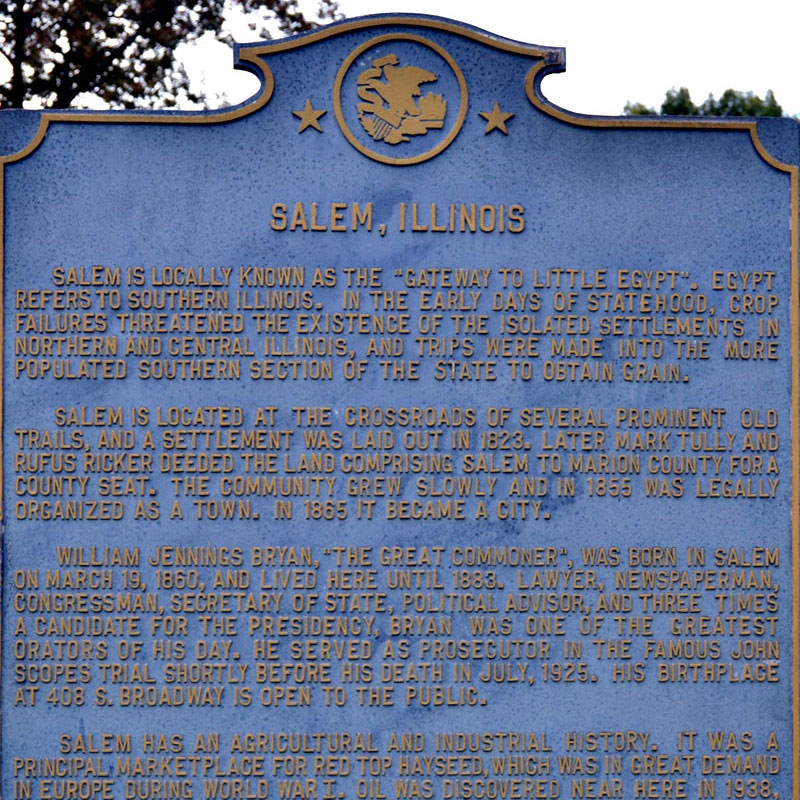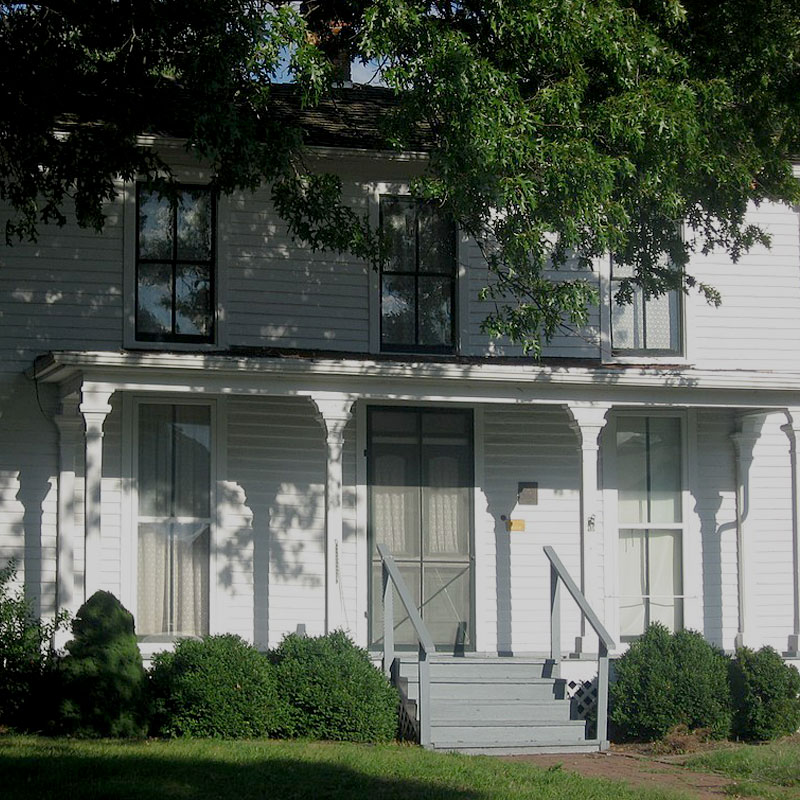It was the largest earthquake in the history of the new American republic that brought the first settlers to Salem. The New Madrid (Missouri) quake of 1811 – the quake that caused the Mississippi River to flow backward and church bells to ring as far away as Boston – sent Capt. Samuel Young searching for a more hospitable home. Finding abundant game and tranquility when he reached present-day Salem, he made camp on what is now the courthouse square.
In the 1820s, a severe drought hit northern and central Illinois, which contributed to the wagon loads of people traveling to southern Illinois to obtain food and grain for themselves and their livestock. As this was compared to the Biblical story of Israel going to Egypt to purchase grain, southern Illinois become known as “Egypt” and also “Little Egypt.” Salem became the “Gateway of Little Egypt.”
Salem was founded in 1823 as the County Seat of the newly formed Marion County. It is situated halfway between the Indiana and Missouri borders on what was originally the Vincennes-St.Louis Road, now U.S. Highway 50 (which goes from Washington, D.C. to San Francisco). Thus, Salem evolved into a stagecoach stop on the Vincennes Trail. Salem snoozed while the western migration of land-hungry settlers passed through its gates. Although most of the conestogas rolled through Salem, enough stopped to deposit their cargoes that Salem was eventually incorporated as a village in 1855. There is a legend of gold associated with one particular stagecoach stop.
William Jennings Bryan Birthplace Museum
On a visit to Bryan Birthplace Museum, you will see many pictures of Williams Jennings Bryan, newspaper clippings, as well as a variety of awards he received. You will enjoy seeing a flatiron and fire tongs from his boyhood home. There are “life masks” of Bryan and his wife, made about 10 years before his death. Furniture that belonged to his parents, including a bookcase, washstand, and a desk, are on display as well. Bryan’s Spanish American war uniform is on display, along with Bryan’s chair from his office in Washington, D.C.
Legend of Half-Way Tavern
There is a legend surrounding the Half-Way Tavern, located on U.S. 50 just east of Salem, a legend concerning lost gold. Some historians say that one day in the early 1800s a stagecoach passing through the area was held up by Indians. The coach was carrying gold which the Indians made off with. When a posse closed in on them they supposedly buried the gold in a wooded area just north of the tavern. And as far as anyone knows, it is still there awaiting discovery.
Naturally, as with all legends dealing with lost gold and lost gold mines, people are said to have sought the treasure. But no one is known to have found it. Farmers have plowed up Indian arrowheads in this area. No farmer, however, ever claimed to find the buried gold.
Half-Way Tavern got its name because it was located halfway between St. Louis and Vincennes. The building was originally constructed in 1815 and was used as both an Inn and livery stable. Stagecoach passengers used the Inn on their travels between St. Louis and Vincennes.
One of the more prominent customers of the Half-Way Tavern – although he probably wasn’t considered so at the time – was a young attorney named Abraham Lincoln. He and other lawyers “rode the circuit” from courthouse to courthouse trying cases in those days. It is highly likely that Half-Way Tavern, lying the location that it does, was visited more than once by the future U.S. president.
Some years ago the state of Illinois took over the property and renovated the old building replica. Now it can be seen by motorists traveling east from Salem on U.S. 50. The building itself is closed to the public.

Half-Way Tavern

Historical Marker

Boyhood Home of William Jennings Bryan
Notable Historical Events
G. I. Bill of Rights
The G.I. Bill of Rights was born in the Luther B. Easley Post No. 128 of the American Legion in Salem, on November 4, 1943. It was drafted by Omar J. McMackin – Salem, Earl W. Merritt – Salem, former Governor John Stelle – McLeansboro, Dr. Leonard W. Esper – Springfield, George H. Bauer – Effingham, William R. McCauley – Olney, James P. Ringley – Lemont, and A. L. Starshak – Chicago. The plan was taken to Washington D.C. by Governor Stelle, who was with President Franklin Delano Roosevelt when he signed it into law on June 22, 1944. The law was officially titled as the Servicemen’s Readjustment Act and was created to assist veterans of active service in the Armed Forces during World War II.
John T. Scopes
Salem is also home of John Thomas Scopes. The following news story is taken from the front page of the Salem Republican dated June 11, 1925. John Thomas Scopes, 24 years, indicted for teaching evolution in Dayton, Tenn., High School is present in New York securing counsel and advisers to face his trial, July 16th.
Merchants of Dayton were not slow to realize the commercial side of this trial. They held a banquet, invited Scopes to attend and mapped out a plan to secure rooms and board to accommodate the people who be attracted by the trial, reckoning it brings thousands of dollars to them. They planned to ride high, wide and handsome in the way of prices, which Scopes says disgusted him and he told them frankly it was a poor sample of southern hospitality and suggested that every visitor be given a square deal.
One of the grand jurors who found the indictment suggested that hanging should be Scope’s portion. Scopes, it will be recalled, graduated with Salem High School class of 1919 on which occasion, Wm. Jennings Bryan delivered the address. [It will be recalled that Bryan was a prosecutor at the trial.]
The whole matter has assumed the portion of Dayton and her merchants endeavoring to secure a large amount of notoriety and publicity with an open question as to whether Scopes is a party to the plot or not.
Kraft Miracle Whip Salad Dressing
Another bit of Salem lore is the creation of Miracle Whip by a local restaurateur. Located at 100 North Washington was Max Crossett’s Cafe. According to the story, Kraft bought the recipe known as Max’s “X-tra Fine Salad Dressing” in 1931 for $300. It was renamed Kraft’s Miracle Whip.
